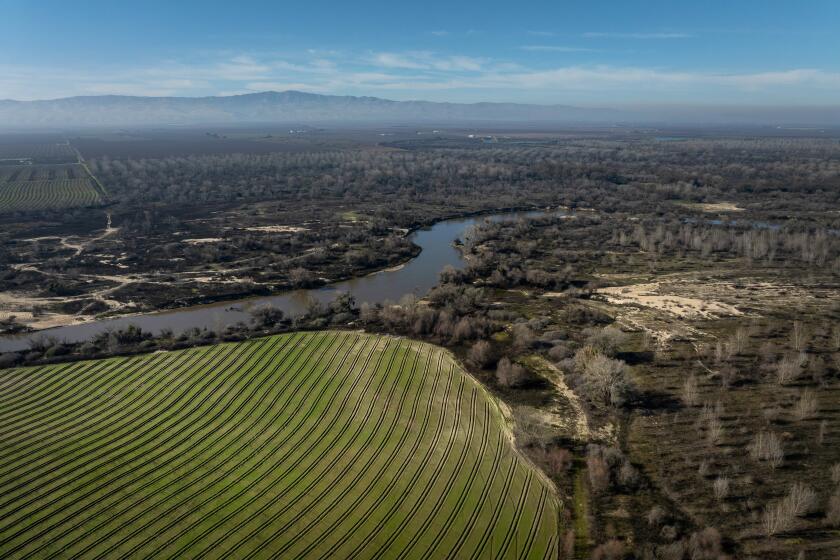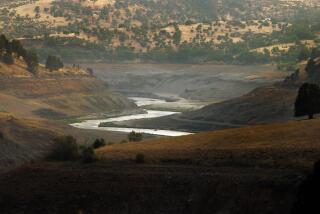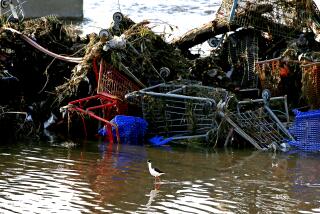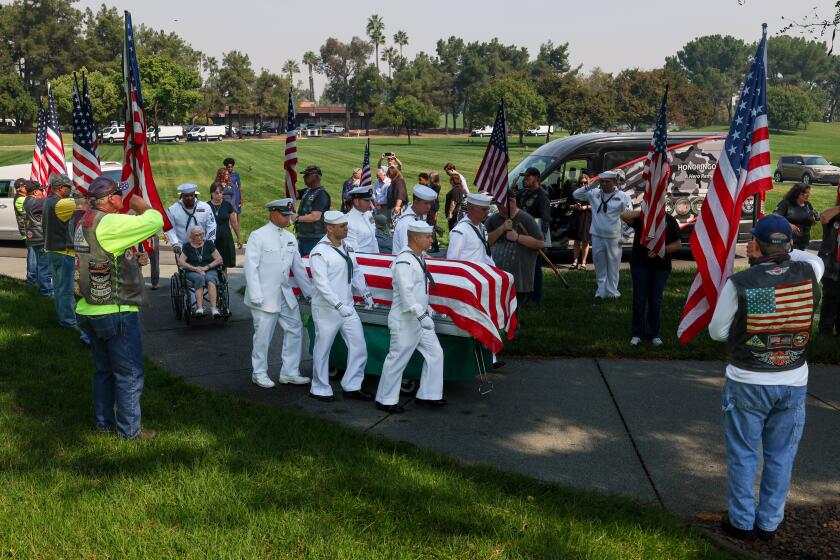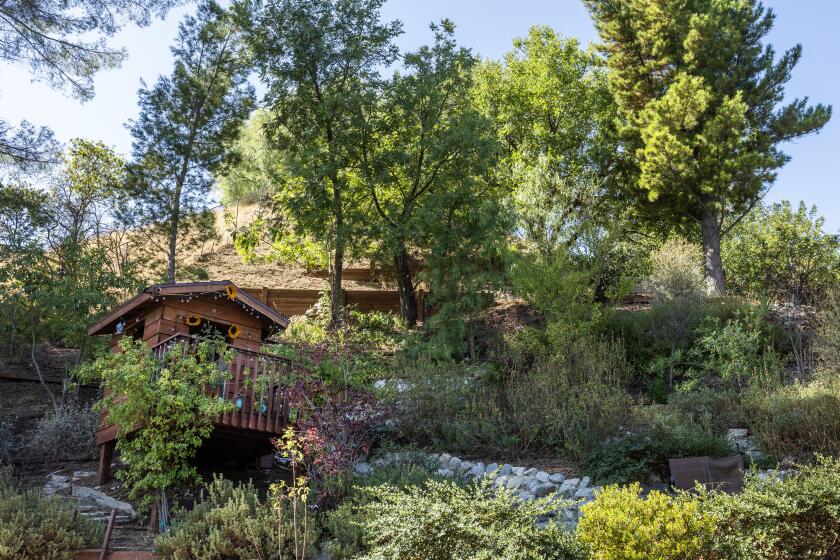
- Melanie Winter is a leading advocate for embracing nature along the L.A. River.
- For nearly 30 years, she has fought to return portions of the watershed to a natural state.
- She continues her advocacy even as she undergoes treatment for lung cancer.
Two canoes and two kayaks glided along, paddles leaving ripples in the still water.
Tall cottonwood trees and willows enveloped the riverbanks in cool shade and swallows soared among the branches. White butterflies floated along the water’s edge.
“How amazing is this! In the middle of L.A.,” exclaimed Melanie Winter, who sat admiring the view from a canoe. “You get a glimpse of what the river was, and what the river could be again.”
This oasis, part of the Sepulveda Basin Recreation Area, is one of the few spots where the Los Angeles River isn’t straitjacketed in concrete, allowing it to flow unencumbered through a thriving riparian forest.
For Winter, it’s a place that shows the potential to solve multiple problems and improve life in Los Angeles by reimagining the city’s heavily engineered channels to make space for nature along the river.

For nearly three decades, Winter has been persistently spreading her alternative vision for the river and the watershed — a vision that includes “unbuilding” where feasible, removing concrete and reactivating stretches of natural floodplains where the river can spread out.
Leading her nonprofit group the River Project, she has won significant victories but has also encountered resistance from engineers and local officials who prefer traditional hard-infrastructure approaches. For as long as she has been doing this work, Winter says, it has felt like a battle. And now another challenge looms: She has lung cancer.
She was diagnosed in November, and in January an oncologist told her matter-of-factly that “chances are better for you, but you’ve got, what, 18 to 24 months.”
While undergoing chemotherapy and taking steroids and other medication, Winter has continued attending meetings, writing letters to object to watershed plans she views as flawed, and speaking to college students about the benefits of rewilding portions of the river.
“I see a different future that is possible, and it is a much healthier city,” she said. “And because it is possible, I feel compelled to fight for it.”
“How amazing is this! In the middle of L.A. You get a glimpse of what the river was, and what the river could be again.”
— Melanie Winter

The canoes and kayaks continued upstream until the group reached an impassable spot where the river was cascading through rocks. Nearby, a great blue heron stood motionless in shallow water. As the boats approached, the heron spread its wings and lifted off.
“That’s very cool,” Winter said, adding that the bird seemed graceful as a ballerina, “the most aloof, elegant, svelte creature ever.”

The group turned and began paddling downstream. Winter rode with her dog Maisie on her lap. Winter had put a life vest on the dog resembling a shark, with a dorsal fin protruding from its back. “My little land shark,” she called her.
As the boats drifted, Winter suggested taking a rest. Steve Appleton, who runs a boating business and was paddling the canoe, steadied the boat while Winter stepped onto the muddy bank with Maisie in her arms. She sat in the shade and chatted with Appleton, her wet sandals resting on hard clay.
“That’s the dream,” she said. “Sitting on a sandy riverbank, under a willow, toes in the water, just letting your mind wander and dream.”
Winter planned the outing on a day when, based on the timing of her cancer treatments, she expected to have enough energy to sit in the canoe for a few hours. She doesn’t see her experience with cancer as a “fight,” as some might describe it, but rather an illness that is giving her “perspective, patience.”
“It sort of deepens the gratitude. It helps you to put things in perspective more frequently than you might otherwise be able or inclined to do,” she said.
And in the same way that she questions how the river is managed, she feels driven to better understand her cancer.
“I feel like there is so much more to learn from this, and I’m finding it very interesting.”
She spoke openly about the illness, the drugs she is taking, and her mortality, at times punctuating her comments with an obscenity. Mostly, though, she talked about the river — its problems and its possible future.
The Los Angeles River heading northwest from Burbank Boulevard in the Sepulveda Basin. (Robert Gauthier/Los Angeles Times)
She said restoring natural riverine areas would help recharge groundwater and reduce the city’s serious flood risks, and that regaining healthy ecosystems along waterways would boost biodiversity, create a network of park spaces, improve air quality and protect public health. Lush riparian vegetation would absorb planet-heating carbon dioxide and also provide natural cooling, helping L.A. adapt to climate change.
Winter believes that “multisolving” through these types of nature-based solutions would enable Los Angeles to heal what she sees as a deeply dysfunctional relationship with its waterways.
Some have called her an environmental activist, but Winter says she sees herself more as an advocate, a generalist, a synthesist, or perhaps an “infrastructuralist” who deeply values natural infrastructure.
“When people ask me what I do, I say I work at the intersection of water, land use and climate change,” she said. “That’s the simplest I can make it.”
Researchers say flooding from a 100-year storm could impact up to 1 million people in and around Los Angeles, 30 times more than previously estimated.
She chose to visit the stretch of concrete-free river in the Sepulveda Basin to show the potential for restoring parts of the river.
For now, much of the basin, a federally owned flood control facility spanning 2,000 acres, remains far from what Winter envisions. One section of the river is lined with concrete, and the remnants of tributary creeks sit in straight ditches.
Winter said the public park near the Sepulveda Dam was designed in a way that effectively “erased” the waterways, making them largely invisible to visitors.
Two years ago, the River Project published a study outlining a proposal to restore the river and five tributaries in the Sepulveda Basin and transform the area into the “green heart” of the San Fernando Valley.
The plan called for reducing the size of three existing golf courses and opening wide corridors where the river and creeks would spread out in the floodplains and water would percolate into the ground.
Winter had hoped the proposal, which won widespread support from environmental advocates, would spark swift action to turn the basin into a world-class river park.
But she was deeply disappointed by the city’s response. This year, the city released a plan that officials say would transform the area and “naturalize” the river, but Winter said the plan would actually keep the basin’s current design mostly intact while failing to prioritize restoration. In a letter, she called the city’s plan misleading and “drained of meaning” in its purported focus on nature-based solutions. She asked that her group’s name be removed from a list of advisory committee members.
Winter has been unafraid to rankle city and county officials as she has criticized the status quo.
Conner Everts, executive director of the Southern California Watershed Alliance, said Winter has been uncompromising as she has faced institutional and bureaucratic resistance. “Sometimes she will be outspoken and stand alone, but she will also figure out how to get things done, which she has done consistently,” he said.
Winter speaks with the authority of a person who has studied her subject for years and has repeatedly needed to explain the basics. She said some public officials have been dismissive, apparently viewing her as “a crazy lady.”

“I’m too enthusiastic. I have passion. That’s terrible,” she said with a laugh. “And I don’t have a degree.”
The setback in her effort to transform the Sepulveda Basin hasn’t deterred her. She has found that the resistance she often faces in her work, like the sometimes energy-sapping effects of her medical treatment, is a reality she must live with and work around.
The L.A. River was encased in concrete starting in the 1940s in response to a series of major floods. Engineers designed the channels to complement flood-control dams and transport water quickly from city streets to the ocean.
In the decades since, much of the watershed has been paved over, and expanding development has encroached along the channels in many areas.
Restoring natural sections of the L.A. River where feasible, in Winter’s view, would mean shifting the way many people think of it — from a flood-control drain to an ecosystem that is an asset and an integral part of the city.
“It would be a living river,” she said.
Along the banks, tree branches were festooned with shreds of plastic trash. Shopping carts and car parts protruded from the water. Unperturbed by the trash, Winter gazed approvingly at the green water, which reflected the blue sky.
“I am relaxed and happy. It is a hot frickin’ day in Los Angeles. And we are not hot, and we are listening to birdsong and watching the water flow. And I think this is good for our mental health and our physical health,” she said.
“I feel refreshed,” she said. “More of this, please.”

Winter’s path to becoming a specialist in watersheds took meandering twists and turns.
She was born in 1958 and grew up in the San Fernando Valley at a time when the area still had orange groves, walnut orchards and horse ranches. Like many people in the Valley, she grew up calling every concrete channel simply “the wash.”
She was a talented dancer, and at 17, after graduating from Cleveland High School, she moved to New York City to start a career as a dancer and actor. She performed on Broadway alongside stars including Jerry Lewis and Lena Horne, and appeared in several Hollywood films.
Efforts to restore river floodplains are expanding in California. Making space for water is increasingly seen as a natural solution for floods and droughts.
She gained a deep fondness for Manhattan, including its walkability and ample green space in Central Park. But after 15 years, she left the city in 1991 and returned to Northridge to help care for her parents as their health declined.
She missed the ease of the subway and disliked having to fight L.A. traffic. She was horrified to see familiar open spaces lost to development as suburban sprawl crept into the mountains around the Valley.
She gravitated toward other art forms and social activism, and found she had a knack for organizing community events.
She organized a river cleanup for the group Friends of the Los Angeles River, and then a pivotal moment came in 1996 when she attended a meeting of the newly formed Los Angeles and San Gabriel Rivers Watershed Council, where she heard activist Dorothy Green.

Green, the founder of the group Heal the Bay, eloquently described how concrete channels had starved the life from rivers by blocking their natural processes, and how the city could boost its local water supply and lessen flood risks through an effort called Unpave L.A. by making room for waterways once again.
“Everything clicked immediately for me,” Winter said. “And my second thought was, I am never going to be bored.”
Encouraged by Green and others, Winter started the River Project. She sued developers and the city to challenge a planned development by the river in Cypress Park. She organized a community coalition to push for the formation of a new state park.

In 2007, she and others celebrated the opening of Rio de Los Angeles State Park, commemorating its founding with a bench designed by local artists and lined with colorful tiles. The bench sits next to wetlands in the riparian forest, where cottonwoods and willows tower over sage bushes and wild roses.
On a recent visit, she rested on the bench, Maisie again by her side. “We can do this in spaces throughout the city,” she said. “Just imagine 200 miles like this throughout Los Angeles, this connected network along the backbone system of our waterways that creates spaces like this for everyone.”
Winter has led community discussions to develop watershed plans, such as a detailed blueprint for the Tujunga and Pacoima washes.
She has found inspiration in historical documents, including the 1930 Olmsted-Bartholomew Plan, in which landscape architects proposed creating room for the river and forming an “emerald necklace” of parklands.
For years, Winter has worked to promote “urban acupuncture” through small-scale projects on residential properties that capture rainwater and allow it to infiltrate into the soil. She led a publicly funded program called Water L.A., which helped capture water at more than 130 sites from Panorama City to South L.A. through strategies including installing rain tanks and gray water systems, replacing asphalt with permeable paving, and converting streetside parkways into stormwater-catching basins with native plants.

She is continuing to promote other projects, including a proposal to convert two old gravel quarry pits into giant reservoirs where storm runoff could be routed to recharge the aquifer and reduce flood dangers downstream.
Winter said if there is a thread that has run through her work, it’s curiosity — a desire to look at how to fix interrelated problems.
“My brain likes to see connections,” she said. In her view, the work of healing watersheds demands recognizing the connections nature provides.
Earlier this year, a group of graduate students from UC Berkeley traveled to Los Angeles to meet with Winter and visit the Sepulveda Basin, where their professor, Matt Kondolf, assigned them to analyze how to go about restoring this stretch of the river.
Kondolf, a river scientist, has known Winter for a decade and said he finds her vision inspiring and encouraging. He said he hopes that her efforts, which he described as “battles for the soul of the river,” will eventually bring more change.
Several months after the students’ visit, Winter walked along the river’s concrete channel explaining how restoring this part of the waterway would capture runoff and reduce L.A.’s reliance on water pumped from hundreds of miles away.
“The opportunity to do the right thing here is phenomenal,” she said.
Achieving change, she said, would also mean breaking with the traditional “man over nature” mindset. “Engineers just can’t wrap their heads around the idea that nature can do it cheaper, better, easier than they can.”

Winter has had a staff that has grown and shrunk over the years, at times reaching as many as 10 people when funding was available and projects were underway. Now, aside from her board, her group is a one-person operation. And with her cancer bringing uncertainty, she said, it makes sense not to have others on staff.
As for the future, she said she hopes when people are researching solutions, they will come across her work — the research, reports and plans — and say to themselves: “I’m not alone in thinking like this.”
“If it can give other people courage to go against the tides, then that would be awesome.”
As she continued along a path near the water, Winter said she hopes that through the ideas she has shared, people will eventually see the wisdom of letting nature take hold and giving the river space to become a living river once again.

